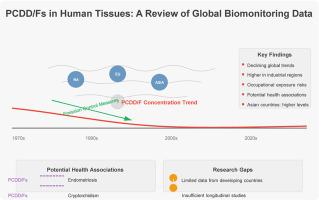人体组织中的PCDD/Fs:全球生物监测数据综述
IF 8.1
2区 环境科学与生态学
Q1 ENVIRONMENTAL SCIENCES
引用次数: 0
摘要
本综述调查了人体内部器官和组织(不包括血液)中多氯二苯并-对二恶英和二苯并呋喃(PCDD/Fs)的浓度,特别关注截至2025年1月在世界范围内进行的脂肪组织研究。对已发表文献的全面分析强调了人类接触PCDD/F的重要地理和时间趋势,包括PCDD/F水平与各种健康状况之间的潜在关联。指出了几个研究空白,并提出了未来研究的建议。来自欧洲、亚洲和北美的研究表明,近几十年来,特别是从20世纪70年代到21世纪初,由于成功的排放控制措施,组织PCDD/F浓度普遍下降。工业化地区的脂肪组织PCDD/F水平通常较高,职业暴露研究显示,与一般人群相比,PCDD/F浓度显著升高。观察到明显的区域差异,一些亚洲国家继续显示相对较高的PCDD/F水平,尽管总体呈下降趋势。该综述还强调了PCDD/F暴露与各种健康状况之间的潜在联系,包括子宫内膜异位症和隐睾症,尽管因果关系尚不清楚。基于生理的药代动力学(PBPK)模型研究估计了这些化合物在人体组织中的分布和积累的有价值的见解。确定的研究差距包括来自发展中国家和其他代表性不足地区的有限数据。同样重要的是要认识到在审查的研究中分析方法和报告单位的可变性,这可能使结果的直接比较复杂化。本综述强调了继续开展生物监测工作的重要性,特别是在代表性不足的地区,以跟踪暴露趋势并保护脆弱人群。本文章由计算机程序翻译,如有差异,请以英文原文为准。

PCDD/Fs in human tissues: A review of global biomonitoring data
This review investigates the concentrations of polychlorinated dibenzo-p-dioxins and dibenzofurans (PCDD/Fs) in internal human organs and tissues – excluding blood – with a particular focus on adipose tissue studies conducted worldwide up to January 2025. A thorough analysis of published literature highlights significant geographical and temporal trends in human PCDD/F exposure, including potential associations between PCDD/F levels and various health conditions. Several research gaps are identified, and proposals for future studies are given. Studies from Europe, Asia, and North America demonstrated a general decline in tissue PCDD/F concentrations over recent decades, particularly from the 1970s to early 2000s, attributed to successful emission control measures. Adipose tissue PCDD/F levels were typically higher in industrialized regions, with occupational exposure studies showing significantly elevated concentrations compared to the general population. Notable regional variations were observed, with some Asian countries continuing to show relatively high PCDD/F levels despite the overall declining trend. The review also highlighted potential associations between PCDD/F exposure and various health conditions, including endometriosis and cryptorchidism, though causal relationships remain unclear. Physiologically Based Pharmacokinetic (PBPK) modeling studies estimate valuable insights into the distribution and accumulation of these compounds in human tissues. Research gaps identified include limited data from developing countries and other underrepresented regions. It is also important to acknowledge the variability in analytical methods and reporting units across the reviewed studies, which may complicate direct comparisons of results. This review emphasizes the importance of continued biomonitoring efforts, particularly in underrepresented regions, to track exposure trends and protect vulnerable populations.
求助全文
通过发布文献求助,成功后即可免费获取论文全文。
去求助
来源期刊

Chemosphere
环境科学-环境科学
CiteScore
15.80
自引率
8.00%
发文量
4975
审稿时长
3.4 months
期刊介绍:
Chemosphere, being an international multidisciplinary journal, is dedicated to publishing original communications and review articles on chemicals in the environment. The scope covers a wide range of topics, including the identification, quantification, behavior, fate, toxicology, treatment, and remediation of chemicals in the bio-, hydro-, litho-, and atmosphere, ensuring the broad dissemination of research in this field.
 求助内容:
求助内容: 应助结果提醒方式:
应助结果提醒方式:


